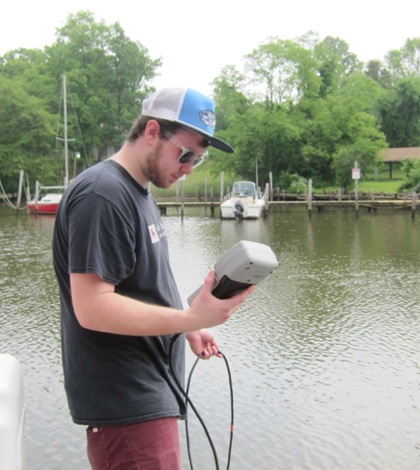300,000-gallon sewage spill has surprisingly minor impacts in Maryland’s Mill Creek

A student samples Mill Creek (Courtesy of Sally Hornor)
On May 28, 2014, an Anne Arundel Community College student stopped on the banks of Mill Creek in Arnold, Maryland, for an ongoing weekly water quality sampling effort there. This week, someone from the county health department was standing on the other bank.
“Are you here sampling because of the spill?'” the county worker said, according Sally Hornor, biology professor at the college. “And he says, ‘What spill?'”
The night before, the Mill Creek Pumping Station lost power and spilled 312,000 gallons of sewage into the headwater of the creek — a tidal tributary to the Magothy River, which flows into Chesapeake Bay. Having just sampled Mill Creek just the week before, as well as every every week every summer going back to 2011, Hornor and her students were in a great position to assess the impact of the spill. The results of that assessment were surprising.
“We really thought this is going to be it for the summer for that creek. It was going to be in truly bad shape,” Hornor said. “But it really wasn’t.”
Their analysis showed spikes in nitrate and bacteria, though both effects were local and short-lived. Other nutrients, including ammonia and phosphate, didn’t show significant increases, neither over the previous year nor compared to a similar creek nearby.
But that doesn’t necessarily mean that either Mill Creek or the control stream are in great shape. Both have small, highly urbanized watersheds that send big doses of nutrients into the water after storms, making for highly variable inputs of nutrients against which spills don’t stand out.
“In these small creeks with small watersheds and lots of development, we see such impacted water quality that even major sewer spills — they have almost no more impact than a heavy rain event,” Hornor said. “Which is kind of crazy. That kind of blew us away.”
Coincidentally, Hornor has overseen monitoring on Mill Creek going back to 2006 as a result of a much larger spill in 2005 from the same pumping station that dumped 3 million gallons of sewage into the creek over 24 hours. The sampling began with temperature, salinity, pH and dissolved oxygen with a YSI meter, as well as Secchi disk readings and enterococci bacteria counts.

The headwaters of Mill Creek (Courtesy Sally Hornor)
The 2005 spill also caused a sediment problem. The flow of sewage scoured a giant hole in the headwaters and sent a significant amount of sand downstream into a small creek that didn’t have a lot of room to handle it. Property owners along the half-meter-deep creek “basically had sand flats at their docks,” Hornor said. Permits for a dredging operation required a study monitoring the impacts of the work, which gave researchers a reason to continue and expand their sampling on Mill Creek. In 2011, they added biweekly sampling for nitrate, nitrite, phosphate, ammonia and chlorophyll.
Their sampling also showed a slight drop in water clarity at upstream sampling sites on Mill Creek, but they didn’t see a corresponding rise in chlorophyll levels. Instead, it appears to have been a sediment effect, as they saw higher levels of total suspended solids. That was likely the effect of a rainy year resuspending sediment in the creek’s mudflat wetland headwaters.
At the downstream sites in both Mill Creek and the control stream, the monitoring actually showed an increase in water clarity. Hornor said that was likely the result of a good year for dark false mussels, a species that periodically shows up in the creeks, especially in years when high rainfall leads to lower salinity in these tidal systems.
“I consider that to be part of built-in the resiliency of this system,” Hornor said.
Top image: Student Greg Wolf samples Mill Creek (Courtesy of Sally Hornor)




0 comments